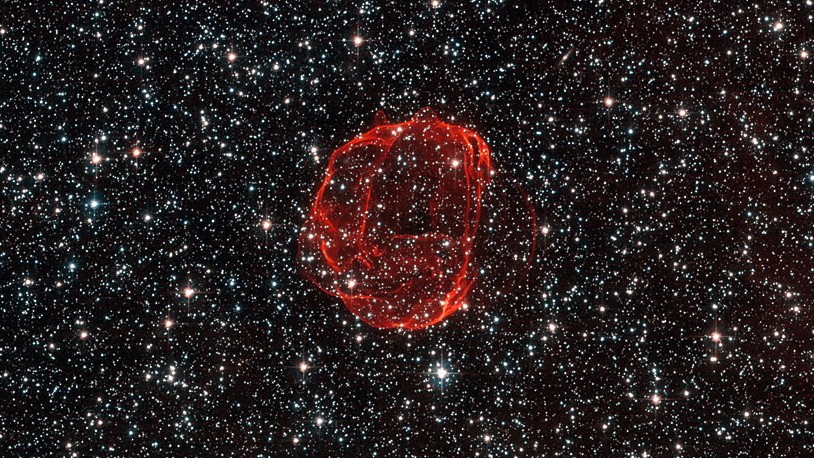Invisible supernovas called 'bosenovas' may be exploding all around us, new research suggests
What happens when an invisible star dies? It erupts in an invisible explosion, of course. New research describes how these unseen 'bosenovas' may behave.

All around the universe, invisible stars may be dying in high-energy explosions, and new research suggests how scientists could actually detect these unseen catastrophes.
In a paper published June 28 in the preprint database arXiv, a team of astrophysicists explored what would happen when boson stars — theoretical large objects made of invisible dark matter — reached the ends of their lives. The result, they wrote, is a massive explosion similar to a supernova, only invisible: a "bosenova."
The invisible universe
Dark matter is a mysterious substance that makes up more than 85% of the mass of almost every galaxy in the universe. While astronomers have found multiple lines of evidence pointing to its existence, all of those lines depend on dark matter's gravitational influence on normal matter. We have yet to detect the presence of dark matter in any other way, so the identity of the particle that's responsible for dark matter remains in question.
Related: Strange star system may hold first evidence of an ultra-rare 'dark matter star'
For years, the leading theory was that the dark matter particle was heavy — as heavy, if not heavier than, particles like protons and neutrons. But searches for the interactions between heavy dark matter and normal matter have come up empty. So now, theorists are turning to models in which dark matter is extremely light.
For perspective, the lightest known particle is the neutrino, which is about 500,000 times lighter than an electron. In the most extreme models, the lightweight dark matter can be billions of times lighter than a neutrino.
If dark matter has such a small mass, it will behave in unexpected ways. For example, instead of zipping around the cosmos like particles, it would slosh around like waves. These waves could also bunch together into tight clumps in a phenomenon dubbed "boson stars," because in these models, dark matter is a kind of particle known as a boson.
Get the world’s most fascinating discoveries delivered straight to your inbox.
These boson stars would maintain equilibrium through the interaction of two competing forces. On one hand is gravity, with the mass of the dark matter always wanting to pull the star into a tighter clump. But the dark matter has energy, which resists the pull of gravity, forming a stable star that would be completely invisible.
As the boson star aged, it would slowly gain mass, either by accumulating new dark matter or by merging with other boson stars, according to the new research. Eventually, the star's mass would increase to a critical tipping point where the energy of the dark matter could no longer resist the pull of gravity — so the boson star would begin to collapse.
This collapse would happen relatively slowly, and at first, nothing catastrophic would happen. But as the dark matter crammed together, individual particles would start to bump into each other, annihilating each other and releasing energy. The energy from the collapse would get released in the form of high-energy, high-velocity particles jetting away from the boson star. However, because these particles would be so incredibly light, they would appear as a burst of dark matter waves emitted by the dying boson star.
As an analogy, when normal stars die in supernovas, they release a tremendous number of photons, or particles of light. But because photons are massless, they appear as waves of electricity and magnetism — light.
By contrast, the hypothetical event described by the researchers, which they dubbed a "bosenova," would be completely invisible. Bosenovas might even be going off near our own solar system, and we would never know it.
The only way to detect a bosenova explosion would be through detectors designed to find ultralight dark matter. Many experiments around the globe are already searching for lightweight dark matter. A bosenova would appear to these detectors as a surge of dark matter coming from a specific direction in the sky, just like a traditional supernova appears as a surge of light. Now that the researchers have outlined what a bosenova signature would look like, they hope these experiments will find traces of those fleeting signals.

Paul M. Sutter is a research professor in astrophysics at SUNY Stony Brook University and the Flatiron Institute in New York City. He regularly appears on TV and podcasts, including "Ask a Spaceman." He is the author of two books, "Your Place in the Universe" and "How to Die in Space," and is a regular contributor to Space.com, Live Science, and more. Paul received his PhD in Physics from the University of Illinois at Urbana-Champaign in 2011, and spent three years at the Paris Institute of Astrophysics, followed by a research fellowship in Trieste, Italy.


